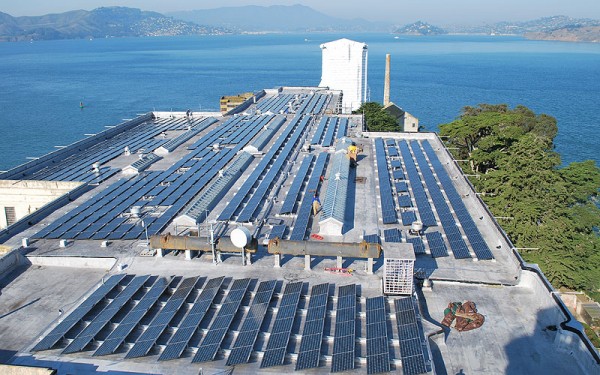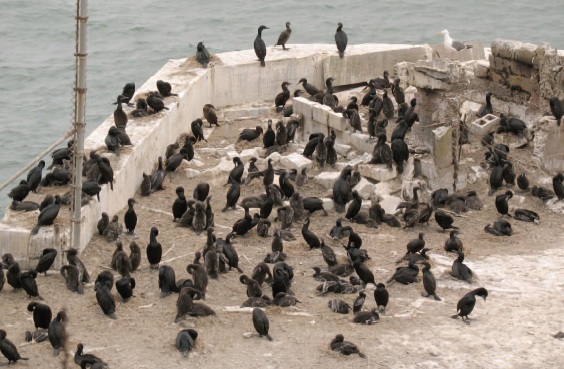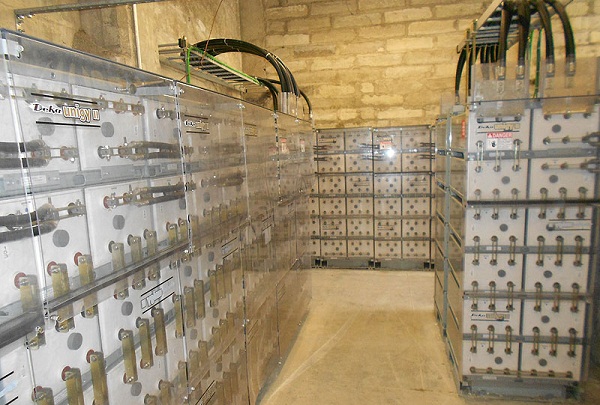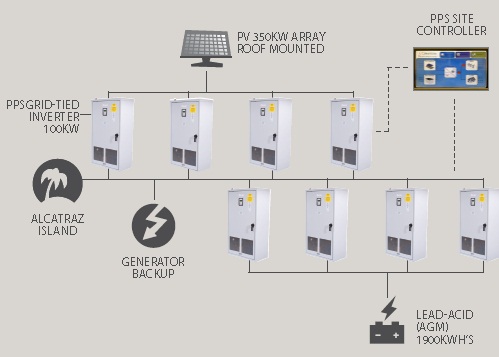It was no easy task getting a thousand or so solar panels past preservationists PO’d at the idea of PV on the iconic Alcatraz penitentiary – and now that the modules are up and operating, there’s the challenge of keeping the bird poop off them.
A National Renewable Energy Laboratory feature detailed the challenge of locating the panels out of view of tourists, but didn’t scrape the surface of the bird-droppings issue. However, Pike Research Senior Analyst Peter Asmus recently visited The Rock and found birds to be “the most persistent issue” for its spiffy new solar-equipped microgrid.

Asmus wrote:
“Though naturalists initially worried that the solar PV panels that cover the roof would scare away birds, gulls have actually found them quite appealing. In fact, they sometimes nest under the panels. Unfortunately, they tend to leave behind their waste, which degrades performance and requires an ongoing, and messy, maintenance task. Kept clean, the solar PV panels can meet the entire island’s power supply, even during San Francisco’s famous fog, which reduces potential output by more than half.”
According to a 2010 report [PDF] by the National Parks Conservation Association, “Since 1975, growing populations of western gulls, Brandt’s cormorants, and other colonial waterbirds have occupied a large portion of Alcatraz Island, including developed areas that have historic structures. The nesting habitat provided by Alcatraz is considered of significant importance in the larger San Francisco Bay Area because development and pollution have decreased suitable nesting areas elsewhere.”

Plans to solarize Alcatraz, using funds from the 2009 stimulus, made news in 2010, “but problems with nesting birds and the visibility of the panels delayed installation,” NREL said.
That wasn’t the first time a solar initiative ran into problems on Alcatraz.
NREL said that way back in 1995, the National Park Service, which oversees the island, and the Federal Energy Management Program contracted with the Sacramento Municipal Utility District to turn the gray lockup green. SMUD actually put a new roof and stanchions for panels on the prison’s New Industries Building, but then a historical landmark group cried foul.
More recently, with the American Recovery and Reinvestment Act pumping money into clean energy projects at parks and historic sites around the country, solar for Alcatraz got new life.
All the delays, it turns out, were a blessing. “Happily,” NREL said, “the progress made by the PV industry over the years — primarily higher-efficiency PV panels — made it possible to put the entire PV system on the roof of the Cellhouse, where it is less visible.”
The system that went in is expected to meet about 60 percent of the island’s energy needs – and that will save the taxpayers money. Yes, the project cost $3.6 million, but with diesel Alcatraz was spending about 76 cents for every kilowatt-hour of electricity used. Now, even factoring in the capital costs of the solar power system – buying it and installing it – that figure will drop to 71 cents, NREL said. And, of course, the solar contribution is a whole lot cleaner.
Alcatraz needs power because it draws 1.4 million visitors annually to tour the pen and visit its museum and retail store. The funny thing is, Alcatraz was a prison – with notorious inmates like Al Capone, George “Machine Gun” Kelly and Robert Stroud, the “Birdman of Alcatraz” – for just 30 years, from 1933 to 1963. That means it has now had a longer run as a tourist attraction than as a prison – this reporter visited Alcatraz on a school field trip in the mid-1970s, not long after Native American protesters ended a long occupation of the island.

Asmus reveals in his Alcatraz essay that for a time Alcatraz relied on power from the utility Pacific Gas & Electric, delivered from San Francisco via underwater cable. But when a ship’s anchor accidentally severed the line, Alcatraz turned to diesel generators.

Asmus reports that the generators are still there, providing power when needed as part of a microgrid that operates with gear from Princeton Power Systems. The solar panels – NREL says there are 1,300 of them, adding up to 307-kilowatts; Asmus puts the size of the system at “nearly 1,000” panels and 350-kW – and the backup generators tie into eight Princeton Power Systems inverters, a 1,900-kilowatt-hour bank of lead-acid batteries and a site controller system.
The end result, NREL said, is a system that “produces close to 400,000 kilowatt-hours of electricity a year, reducing carbon dioxide (CO2) emissions by about 337,000 kilograms a year.”